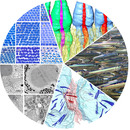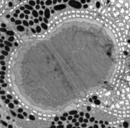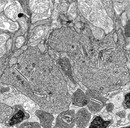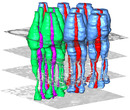Master Thesis
Histology and fine-structure of triple-cones in the retina of the European anchovy (Engraulis encrasicolus)
 In contrast to other vertebrates the retina of the European anchovy Engraulis encrasicolus (and some other anchovy species) is designed for polarisation-contrast vision. This sensitivity is caused by a unique cellular and subcellular architecture of the retina and their pigment epithelium: two cone types with radially oriented outer segment lamella (arranged in poly-cones), the lamellae of neighbouring cones are orthogonally orientated to each other, are interlocked with a wedge-shaped pigment epithelium with an integrated interference-mirror. Besides these poly-cones another type of compound photoreceptors, i.e. triple-cones with two large lateral components and one small central component, is located in the ventral and dorsal region of the retina. These triple cones most probably subserve bichromatic color-contrast vision.
In contrast to other vertebrates the retina of the European anchovy Engraulis encrasicolus (and some other anchovy species) is designed for polarisation-contrast vision. This sensitivity is caused by a unique cellular and subcellular architecture of the retina and their pigment epithelium: two cone types with radially oriented outer segment lamella (arranged in poly-cones), the lamellae of neighbouring cones are orthogonally orientated to each other, are interlocked with a wedge-shaped pigment epithelium with an integrated interference-mirror. Besides these poly-cones another type of compound photoreceptors, i.e. triple-cones with two large lateral components and one small central component, is located in the ventral and dorsal region of the retina. These triple cones most probably subserve bichromatic color-contrast vision.
In the present master thesis (1) the transitions between triple- and poly-cones are mapped in light-microscopic resolution, and (2) the fine structure of the outer plexiform layer, the first level of intra-retinal information transfer, is investigated. 3D electron microscopy is used to uncover the architecture of the triple-cone pedicles with their synaptic ribbons, and to find first evidence for wiring rules between photoreceptors and secondary neurons.





